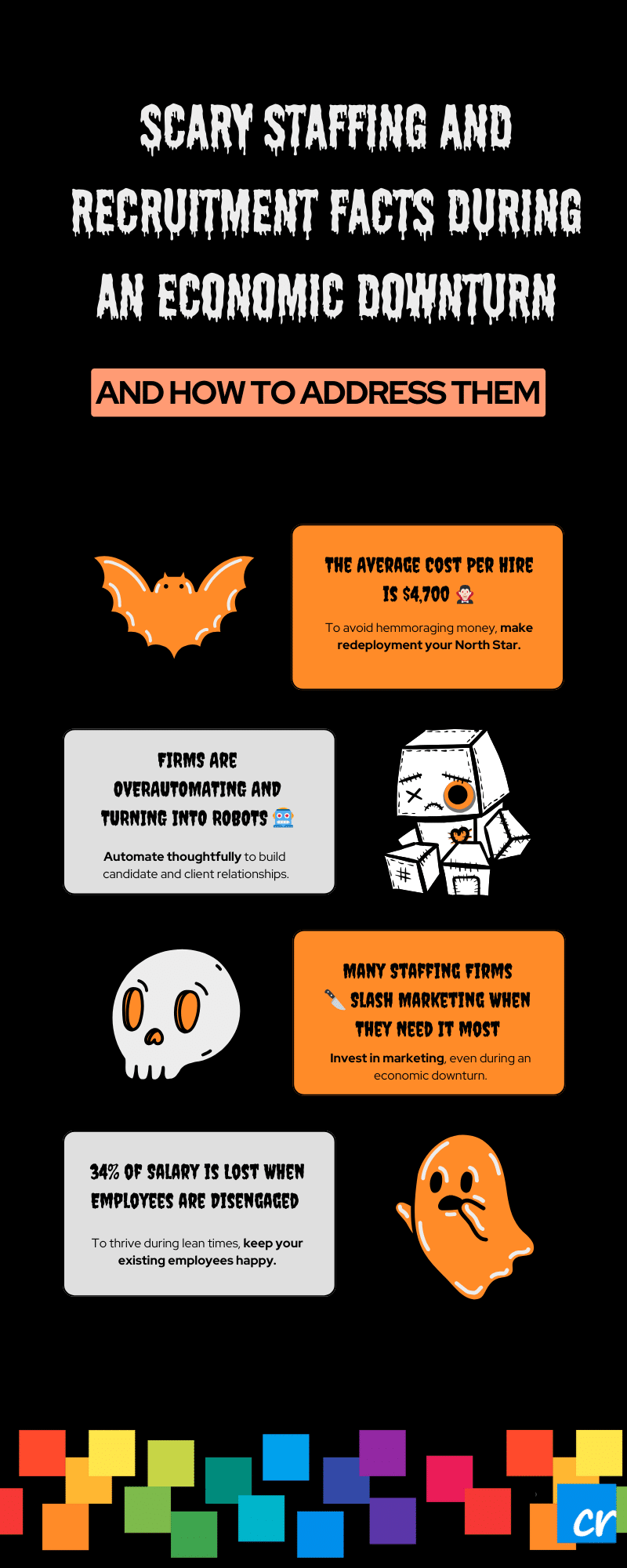
You’ve seen the doom and gloom on every news site, every financial forecast, for a long time now. Though experts disagree on when the storm will hit and how intensely it will impact the economy, a financial downturn of some sort seems likely.
Many cautious business leaders have an impulse to batten down the hatches when the newscasters start saying the word recession.
But growth in the staffing and recruiting industry – even when times are tough – is within reach.
Growing during lean times is all about making the most of what you already have. This means capitalizing on your existing assets, from your loyal candidates to your top recruiters.
It also means investing in the tools and tactics that will help you and your team maximize outreach, productivity, and efficiency in order to do more with less.
Here’s how to grow in staffing and recruitment even during an economic slowdown.
1. Make candidate redeployment your North Star.
According to SHRM, the average cost per hire is nearly $4,700, and that number shoots up to over $28,000 when looking at executive hires. Though staffing and recruitment agencies might not accrue hiring costs at the same rate as their clients, this gives a sense of the amount of resources it takes to secure new hires.
Think of all it took to get your existing candidates in the door:
- The dollars spent on LinkedIn ads, job boards, and website overhauls.
- The hours recruiters spent corresponding with poor-fit candidates in order to find the right match.
- The time spent by your entire team screening, interviewing, credentialing, and training.
Each candidate in your database who has already worked for one of your clients represents your team’s best work.
So, when you are looking for ways to expand without spending more, focusing on redeployment makes a ton of sense. These candidates already know and love your firm because your team has invested time and money in their happiness. Putting these candidates to work for new clients makes that investment pay off even more.
Here are some ways to let your existing candidates know you have their backs during an economic downturn:
- Craft targeted, personalized email campaigns that connect candidates with positions that are made for them. Be thoughtful about this outreach so that candidates know you’re thinking of them and not just sending them generic blasts.
- Send quick check-in text messages that don’t have any agenda or job offer. These just let candidates know that their recruiters are thinking of them and wondering how they are.
- Don’t ignore candidates who have moved on to permanent roles. As many as 90% of passive candidates are interested in new roles – so don’t neglect your tried and true employees just because you think they’re settled.
Track your redeployment rate. Not only will this give you a good idea of how successful your outreach efforts are, but it is also a good indicator of the overall health of your organization. If you have a tanking redeployment rate, it may be time to examine why your candidates tend to stand you up after just one dance.

2. Keep your existing employees happy.
This may seem like a no-brainer, but many companies, especially in times of economic stress, turn to organizational or structural changes instead of focusing on their most important asset: their employees.
First, the economic cost of unhappy employees is gargantuan. Each disengaged employee costs you about 34% of their salary. That means a disengaged recruiter making $60,000 at your firm costs you over $20,000 in lost productivity, missed work, and reduced profitability.
Add to that cost to the previous high price tag of finding a new hire, and it’s clear that, from a purely financial perspective, keeping your employees engaged and happy is the smarter choice.
Then, there are the softer costs to consider. As a staffing and recruitment firm, your brand is built on your ability to create happy employees. Candidates and clients alike want to work with a talent agency that can find the best-fit employees for their own organization.
Your candidate-facing team needs to sing your praises. In order to bring in new candidates, they need a genuine passion for connecting people with the jobs they want.
If they’re unengaged, your candidates – and your bottom line – are going to feel it.
Your client-facing team needs to walk their talk. It’ll be tricky for any client to sign with you if your own employees have one foot out the door.
So, here are some ways to invest in your current employees and keep them happy:
- Beef up your professional development and skills-gap training so employees can feel more motivated, future-focused, and successful.
- Create an open-door policy for employee feedback so you can address problems before they become issues.
- Involve your employees in problem-solving and in crafting your organization’s future. This will help create ownership, increase personal investment, and create a greater sense of autonomy.
- Build your tech stack around your employees’ needs. Your technology is meant to serve the greater good, so make sure it works with your team rather than making their lives harder.
- Don’t just pay lip service to work-life balance. Talk to your employees about what they need to thrive. Prioritize health and wellness assistance, talk about mental health needs, and give employees space to be fully human at work.
3. Invest in marketing.
It is one of the great ironies of the business world that precisely when a company needs money the most is when they decide to shut off its primary source of new revenue. History has repeatedly proven that during a slowdown, businesses actually benefit more from advertising. – Dennis Kirwan in Forbes.
Many businesses tend to think of their marketing budget as an optional expense. Especially when the going gets tough, ad spend, content creation, and social media curation often end up on the chopping block. Even for organizations that’ve seen great returns from a wise marketing campaign, the temptation to focus on more “direct” methods for generating leads is often great.
However, this is a misstep for multiple reasons.
First, many of your most effective marketing strategies build strength and ROI over time. “You may jeopardize long-term growth if you stop marketing to reduce short-term costs,” said marketing legend Neil Patel. Scaling back your social engagement or cutting organic outreach not only immediately stops your growth, but it can also set you up for failure down the line.
Second, marketing not only directly generates leads, but it also is a crucial part of your relationship-building with your prospects, candidates, and clients. The umbrella term of marketing often encompasses email outreach to your existing candidate database, text campaigns to dormant candidates, and retargeting campaigns that keep your firm top-of-mind for your clients and future clients.
And finally, because many of your competitors will cut back on their marketing spend during tough economic times, your marketing efforts will likely become more effective as the space becomes a bit less crowded.
Here are some tips for marketing during an economic downturn:
- Talk about the economic downturn in outreach. Use the shared reality of economic struggle to create a common ground with your prospects. Because everyone is going through rough financial times, addressing it directly can help create connections.
- Prioritize content that brings value to your prospects. During tough economic periods, potential candidates are going to be laser-focused on value. With helpful content, expert thought leadership, and empathetic outreach, you can show how much your agency adds value to everyone you work with.
- Right-size your marketing KPIs. Though smart marketing is always valuable, the needle may not move as quickly during an economic downturn. Be sure your expectations are realistic.
- Automate your outreach. Using your tech stack to save time and money on marketing efforts can help you expand your reach without breaking the bank.
4. Use AI and automation thoughtfully.
The reason that AI and automation are discussed so much is that they are both revolutionizing how we do business. Tools like ChatGPT and workflow automation are rapidly evolving, and each new iteration provides opportunities for people in every industry to innovate their day-to-day processes.
What’s more, these tools often provide huge time and energy savings at a relatively low cost, which makes them natural choices in times of economic trouble.
But, there’s a temptation when new technology comes along to try and overapply it to every situation. And, there’s a similar temptation in times of crisis – with your latest AI tool in hand like a high-tech hammer, you may look out at all your organization’s problems and see only nails.
When adopting AI solutions, proceed cautiously. Staffing runs on relationships, and too much ChatGPT and automation may leave your organization sounding like a robot.
Here are some tips on how to adopt AI and automation thoughtfully:
- Look to automate time-consuming processes that drain your team’s time without adding direct value to candidates. For example, sourcing, credentialing, and workflow notifications all lend themselves easily to automation.
- Use tools like ChatGPT to help your team do work faster and more creatively rather than replacing human work altogether. For example, you may tap ChatGPT to help your team generate ideas for email subject lines or blog post outlines.
- When it comes to relationship building, stick to a human-first philosophy. For any high-value touchpoints, skip automation and AI.
For more automation and AI tips, check out our blog post, What and When to Automate in Staffing and Recruiting… And When You Just Shouldn’t.
5. Prioritize tech choices that help your team work smarter.
No matter what the financial landscape, you want to make tech choices that empower your team. But when you’re facing a recession or any time when you need to tighten the belt, your tech choices can make the difference between merely surviving and truly thriving.
Think of your tech stack not as a collection of tools to solve siloed problems but as a holistic system that works with your team to be more efficient, more productive, and more profitable.
To create this kind of team-tech symbiosis, you need a system that works with your team, rather than forcing them to adapt the way they work to the tech. Here are some hallmarks of smart, flexible tech choices:
- Your tech helps your team improve their workflows and automate the kinds of tasks that they hate doing.
- Your technology also improves candidate and client experiences, creating seamless interactions.
- Your solutions fully integrate with each other to create a single, unified system rather than a series of separate tools.
- You have a single source of truth, and your data isn’t siloed in different tools.
Just because the economy is a bit frightening doesn’t mean your firm needs to duck and cover until the danger passes.
By prioritizing existing candidates and employees, you can make the most of the people who make your business thrive in the best of times.
By making thoughtful choices when it comes to marketing and tech spend, you can ensure that you can continue to bring in new prospects and grow your bottom line.

